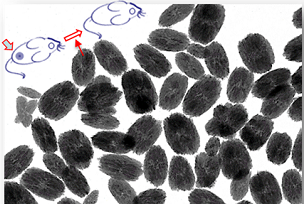Nanomedicine
 Current cancer treatment methods are imprecise and heavily taxing on the patient, targeting both healthy and mutated cells. Morphologically controlled 200 nm vaterite CaCO3 nanoparticles were synthesized as pH neutralizers to be used for cancer therapy. The development of cytoplasmic pH neutralizers is a novel approach for cancer therapy that eliminates the negative side effects of existing therapies such as chemotherapy and other radiation based treatments by targeting cancer cells. In addition, aerosol based drug delivery methods tailored for direct transport to the brain were developed. In the preliminary results of experiments carried out on locusts, it was observed that 5 nm spherical gold nanoparticles, functionalized with a thiol group, can be delivered to the brain by axonal transport. This finding provides support for this novel and effective drug delivery method.
Current cancer treatment methods are imprecise and heavily taxing on the patient, targeting both healthy and mutated cells. Morphologically controlled 200 nm vaterite CaCO3 nanoparticles were synthesized as pH neutralizers to be used for cancer therapy. The development of cytoplasmic pH neutralizers is a novel approach for cancer therapy that eliminates the negative side effects of existing therapies such as chemotherapy and other radiation based treatments by targeting cancer cells. In addition, aerosol based drug delivery methods tailored for direct transport to the brain were developed. In the preliminary results of experiments carried out on locusts, it was observed that 5 nm spherical gold nanoparticles, functionalized with a thiol group, can be delivered to the brain by axonal transport. This finding provides support for this novel and effective drug delivery method.
Nanofood and Nanosensors
 Malnutrition and food availability is major problem for the growing global population.
Malnutrition and food availability is major problem for the growing global population.
In this field, nanonutrient fertilizers are being developed for enhanced crop production. These fertilizers enable increased sunlight harvesting and native nutrient mobilization in the rhizosphere. Both 25 nm ZnO and anatase TiO2 nanoparticles were observed to serve as effective nanonutrients for tomato plants by increasing chlorophyll, biomass, and lycopene content in the ripened fruit. Novel nanofertilizers not only reduce the demand for chemical fertilizers but also improve human health by producing nutrient rich foods. In addition to nanomedicine and nanofood, it is very important to detect when food is no longer edible; therefore, highly sensitive graphene-based gas nanosensors are being developed to monitor fruit freshness for use in quality control measures.
Toxicology
In considering the full spectrum of impacts of nanobiotechnology, toxicity and the potential negative effects of these novel particles cannot be ignored; therefore, environmental toxicity based on nanoparticle morphology and composition was measured. A correlation between the mass, number, and surface area concentration, as a function of nanoparticles size, is being developed to define LD50 for nanoparticle based toxicity assessments.